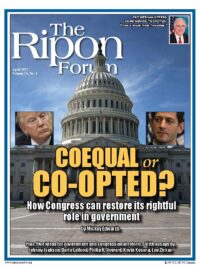
As Wilber Ross and Peter Navarro wrote in the Trump campaign white paper, “[t]oday, much of America’s infrastructure is crumbling. Much more needs to be built anew.” The American Society of Civil Engineers agrees — the organization’s recent Infrastructure Report Card gave U.S. infrastructure a grade of D+.
But if new infrastructure spending is to be effective in growing the economy long term, and not just a Keynesian sugar high, it must move beyond simple concrete and rebar. Any infrastructure package should focus on smart infrastructure that integrates both physical and digital aspects, and at least some support should go to pure digital infrastructure. Smart infrastructure and robust broadband networks can deliver the next wave of innovation and economic growth.
Some see infrastructure as having little capacity for innovation. Roads and bridges spring to mind, which have changed little over the years. While there may be innovations in physical infrastructures, today’s biggest opportunities for improvement are in embedding digital technologies in physical infrastructure. Sensors, smart meters, and remote-control technology can dramatically improve the efficiency and performance of everything from sewage pipes and waterways to railroads and highways.
Upgrading our nation’s dated physical systems and augmenting them with information technology presents a true opportunity, but all those sensors and meters must be connected. An infrastructure package should look to expand broadband performance in rural areas. In addition to connecting infrastructure, broadband use is an engine of economic growth in and of itself.
In addition to connecting infrastructure, broadband use is an engine of economic growth in and of itself.
One of the core questions regarding any infrastructure project is the appropriate mix of public and private involvement. Some projects are designed, built, managed, and financed by government, others by the private sector. Most involve a mix. While it is not possible to say a priori which functions are best served by public or private actors for all infrastructure projects, everything else being equal, private-sector ownership and operation brings several advantages, most notably a greater incentive for efficiency, innovation, and investment.
Public ownership or operation of infrastructure makes the most sense for true public goods: resources that are both non-excludable (meaning it’s difficult to prevent access to those who have not paid) and non-rivalrous (meaning consumption by one doesn’t prevent simultaneous use by another). It is often difficult to price public goods based on use, so there is little to no incentive for the private sector to provide these services, justifying government intervention. Broadband does not fall into this category.
But there are other circumstances where the government should intervene, if not through outright operation, at least in financing. One such circumstance is where the overall benefits are great, but it is impossible to turn a profit because costs are too high or hard to recoup. This is extremely relevant in the rural broadband context, where the costs-per-home passed are much higher than in more-densely populated urban areas, and revenues from customers simply are not enough to recover the initial investment.
Broadband sees significant network externalities, where the benefits of bringing more users onto broadband networks benefits the broader economy and society, not just individual users. That does not mean that every potential user should obtain subsidized broadband. In many cases, such as very remote households, the combined private and public benefits of connectivity do not necessarily exceed the very high costs of connection. But the benefits of being able to organize our society under the assumption that all have access to the Internet (online banking, e-filing taxes, and digital education tools) justify targeted government investment.
Thankfully, the existing private-investment framework for broadband has seen tremendous achievement, attracting extraordinary capital expenditures (about $1.5 trillion over the last 20 years). This investment has made U.S. broadband a remarkable international success story, especially considering the high cost of laying wires through this nation’s suburban sprawl. But in some parts of the country, particularly rural, high-cost areas, the economics simply do not support much in the way of private investment, resulting in a real gap between rural and urban broadband performance.
According to FCC data, as of December 2014 there were approximately 34 million U.S. residents (or 10 percent) without home access to a fixed terrestrial service of at least 25 megabits per second (Mbps). Note, existing broadband buildout efforts — largely thanks to private investment — see continual improvement: This number of Americans without access to high-speed broadband is down 38 percent from just a year prior.
But when you look only at rural areas, the picture isn’t quite as rosy. Thirty nine percent of rural Americans lack access to high-speed broadband, and even at modest speeds, 25 percent of rural residents lack 10 Mbps. Compare that to 4 percent of urban residents who lack access to high-speed.
Thirty nine percent of rural Americans lack access to high-speed broadband. Compare that to 4 percent of urban residents who lack access to high-speed.
The case for including support for accelerating broadband deployment as part of an infrastructure package is strong, but that support should be carefully designed to see it used most effectively. Tax incentives can be a useful tool, incenting additional investment at the margin. But for truly high-cost areas, geographically targeted subsidies designed to achieve specific goals are necessary to move the dial.
Support should first supply a single network for truly unserved populations before attempting to upgrade performance of existing slower networks. There is a misperception that the economic benefits of broadband require significantly higher speed networks. Study after study shows that the economic benefits of broadband are greatest when adding additional users at any speed, not upgrading networks to supposedly “future-proofed” technologies. There is a clear and large diminishing marginal utility to additional network speed, and often upgrades to speed can be far more cost effective compared to deploying an entirely new network.
A wide variety of prior programs have attempted to improve rural broadband with varying success. The Federal Communication Commission’s Connect America Fund (CAF) is the most well thought out and successful of these programs. An infrastructure bill could simultaneously put CAF funding on surer footing and define cost-effective goals for rural broadband improvements.
On the other end of the spectrum, various grant and loan programs under the Department of Agriculture’s Rural Utilities Service (RUS) provide an example of how not to advance rural broadband. RUS has faced some accountability challenges, and many of the networks benefiting from its guaranteed loans have creeped into low-cost areas, cherry-picking high-return multi-dwelling units that are already served competitively. It would be a mistake to expand this program as part of an infrastructure bill without significant reform.
Federal financial support could also be used to encourage local jurisdictions to take additional steps to remove barriers to deployment. Local and state governments should streamline access to public rights of way and utility poles, adopt “dig-once” policies, and ensure fees to access city infrastructure are based on cost and are competitively neutral.
Most of all, it is important for broadband infrastructure spending to focus first on areas that are legitimately unserved rather than propping up duplicative, smaller networks or increasing available speeds beyond what is reasonably needed. If policymakers want to have the largest impact when subsidizing broadband infrastructure investment, they should prioritize bringing online those populations without any available connection at all.
Doug Brake is a senior telecommunications policy analyst at the Information Technology and Innovation Foundation, the top-ranked U.S. science- and tech-policy think tank.




